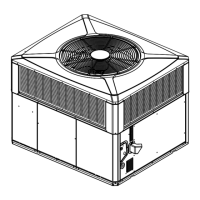28
18-BG07D1-1B-EN
heating continuously or cycle between high fire gas
heating and low fire gas heating.
CCyycclliinngg oonn hhiigghh ffiirree 22nndd ssttaaggee ggaass hheeaatt::
When the thermostat cycles on high fire gas heating,
power will be removed from (W2/X2) and (W1) will
remain powered. The control module (IGN) will switch
the gas valve (GV) to first stage and the induced draft
blower (CFM) to low speed. After approximately 30
seconds the indoor blower motor is reduced to low
speed.
NNoottee:: During gas heating operation, the indoor blower
is controlled by the normal sequence of gas
furnace operation, and not by the thermostat.
TTrraannssiittiioonniinngg ffrroomm hhiigghh ffiirree 22nndd ssttaaggee ggaass ttoo llooww
ffiirree 11sstt ssttaaggee ggaass::
The thermostat will begin to operate continuously on
low fire gas heating or will begin cycling on high fire
gas heating.
TTrraannssiittiioonniinngg ffrroomm llooww ffiirree ggaass hheeaattiinngg ttoo hheeaatt
ppuummpp ooppeerraattiioonn::
When the thermostat is cycling on low fire gas heat, the
load may decrease to the point where the thermostat
determines that the heat pump would have sufficient
capacity to maintain the indoor temperature at the
desired setpoint. When this occurs, power will be
removed from (W1). This will cause the gas valve (GV)
to close and the control module to de-energize the
induced draft blower (CFM) after approximately 5
seconds postpurge. The indoor blower motor (IDM) will
continue to operate (with no (G) signal) for the blower
off period (45 or 90 seconds) while the heat exchanger
cools down. At approximately 45 seconds after power
was removed from (W1), the thermostat will apply
power to (Y1). This powers the compressor contactor
(CC) which starts the outdoor fan motor and
compressor. The thermostat will also apply power to
(G) at this time so that the transition from gas heat to
heat pump will not interrupt indoor airflow. The
purpose of the 45 second delay is to give the indoor
coil sufficient time to cool down before resuming
compressor operation.
TTuurrnniinngg ooffff ffrroomm 11sstt ssttaaggee::
Same sequence as cycling on 1st stage heat (described
previously) except that the thermostat will make the
transition to off as described previously and will keep
the heat pump turned off.
**CCOONNTT880022 aanndd **CCOONNTT880033 OOppeerraattiioonnaall DDiiffffeerreenncceess
ffrroomm tthhee aabboovvee sseeqquueennccee::
NNoottee:: Unlike the *CONT402, these two controls will not
call for the furnace to operate when the outdoor
temperature is above the selected outdoor
temperature changeover point even if the heat
pump capacity is not enough to maintain the
indoor temperature at the desired heating
setpoint. If it is anticipated that the installer
selected outdoor temperature changeover point
from heat pump to furnace must be set to a
temperature at or below where this occurs, then
the *CONT402 control must be used instead of
the *CONT802 and *CONT803 Comfort Controls.
These two controls are not able to cycle on first stage
gas heat in the same way as the *CONT402. The
*CONT402 can cycle the gas heat on and off to
maintain the indoor temperature at the desired heating
setpoint without transitioning to heat pump operation
each cycle if the building load is relatively high. These
two controls will cycle on first stage gas heat by
alternating between gas heat and heat pump operation.
These two controls may take up to 25 minutes to
transition between heat pump and gas operation.
These two controls require a field installed jumper wire
between the W1 and W2/X2 low voltage wires at the
4DCZ5 unit since these two controls produce only a W1
output for auxiliary heat. This jumper will result in low
fire gas heating for 10 minutes or for as long as W1 is
present if less than 10 minutes during auxiliary heating.
Then, if the W1 signal is still present from the Comfort
Control, the 4DCZ5 unit will transition automatically to
high fire and operate on high fire for the remaining
duration of the call for auxiliary heat. During
Emergency Heat mode operation these two controls
will first energize X2 on a call for heat and will
potentially energize W1 as well. In contrast, the
*CONT402 Comfort Control will first energize W1 on a
call for Auxiliary or Emergency Heat mode and will
potentially energize W2 as well as required by the
building load.
DDEEMMAANNDD DDEEFFRROOSSTT OOPPEERRAATTIIOONN
During the heating cycle, the outdoor coil may require
a defrost cycle which is determined by the demand
defrost control (DFC). This control continuously
measures the outdoor coil temperature (CBS) and the
outdoor ambient temperature (ODS-B) and calculates
the difference or delta-T measurement. An initiate
delta-T is calculated based on the delta-T
measurements obtained after defrost terminates (when
the outdoor coil should be clear of frost). When the
measured delta-T during heating operation reaches the
calculated initiate delta-T, the demand defrost control
(DFC) opens the circuit to the outdoor fan motor (ODM)
and energizes the switch-over valve (SOV), placing the
unit in the cooling mode to defrost the outdoor coil.
The outdoor coil temperature sensor (CBS) terminates
the defrost cycle, or times off after twelve, fifteen, or
twenty minutes in defrost, the (DFC) energizes the
outdoor fan motor (ODM) and fifteen seconds later de-
energizes the (SOV), which returns the unit to the
UUnniitt SSttaarrttuupp

